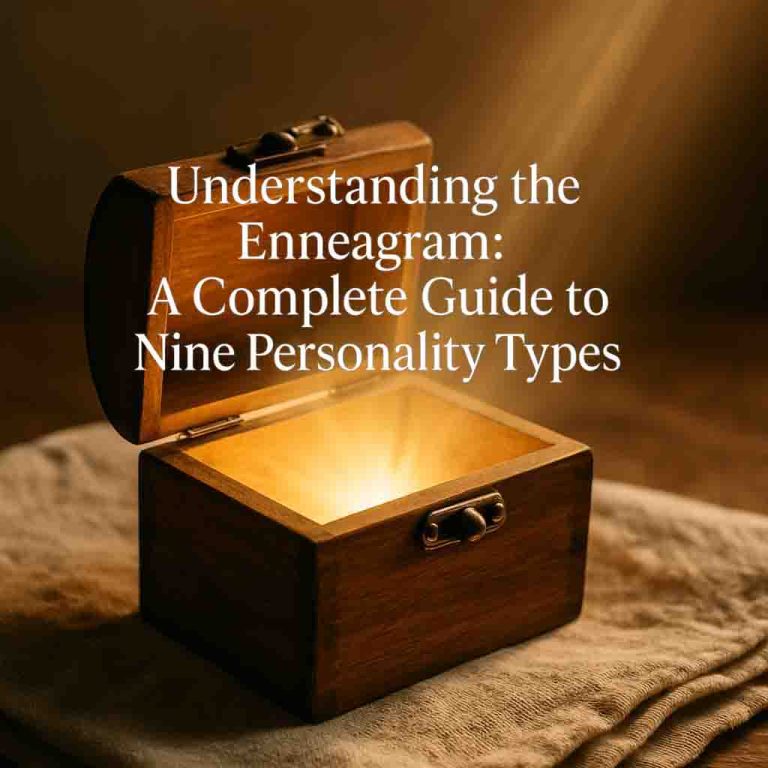Enneagram Centers of Intelligence: How Head, Heart, and Body Shape Your Type
Approx read time – 15 minutes
Have you ever wondered why some people immediately analyze a situation, while others trust their gut instinct or focus on how it makes them feel? This fundamental difference in how we process life reflects our dominant Enneagram Center of Intelligence.
The Enneagram system recognizes three primary centers through which we perceive and respond to the world: Head (thinking), Heart (feeling), and Body (instinctive). Each of us relies predominantly on one of these centers, creating distinct patterns in how we make decisions, handle stress, and connect with others.
Understanding your dominant center is transformative—it illuminates why you respond the way you do and reveals both your inherent strengths and potential blind spots. While understanding the Enneagram’s nine types provides a detailed map of personality, grasping the three centers offers a powerful framework for deeper self-awareness and more balanced living.
Unlock your personality blueprint with our exploratory assessment
Table of Contents
The Three Centers of Intelligence in the Enneagram
The concept of three centers of intelligence has ancient roots in wisdom traditions that recognized humans process experience through multiple faculties. In the modern Enneagram system, these centers represent different forms of intelligence that influence how we navigate the world.

The Head Center focuses on thinking intelligence—our capacity to analyze, strategize, and envision possibilities. Those who primarily operate from this center process life through mental activity, seeking security through understanding and anticipating what might happen.
The Heart Center embodies emotional intelligence—our ability to connect, empathize, and recognize what matters. Those primarily operating from this center process life through feelings and relationships, seeking significance through how they’re perceived and valued by others.
The Body Center represents instinctive intelligence—our capacity for embodied knowing, action, and presence. Those primarily operating from this center process life through physical sensations and gut responses, seeking security through asserting personal boundaries and maintaining autonomy.
While we all possess all three forms of intelligence, most people habitually rely on one center, use another as backup, and leave the third relatively undeveloped. True wisdom emerges when all three centers work in harmony, creating a balanced approach to life’s challenges.
Identifying Your Dominant Center of Intelligence
Determining your primary center begins with honest self-reflection about how you typically process experiences:

- Do you primarily ask “What do I think about this?” focusing on understanding, analyzing information, and planning for possibilities? You may lead with your Head Center.
- Do you primarily ask “How do I feel about this?” focusing on emotional responses, connections with others, and questions of identity? You may lead with your Heart Center.
- Do you primarily ask “What should I do about this?” focusing on physical sensations, immediate action, and establishing boundaries? You may lead with your Body Center.
The Sacred Trinity: Awakening Your
Three-Fold Intelligence Through Ancient Wisdom
“Journey into the mystical realm where mind, heart, and body converge as sacred allies in your spiritual evolution. This profound meditation draws upon thousands of years of wisdom traditions that recognized the human being as a three-fold temple of consciousness, each center holding unique keys to enlightenment and wholeness. Whether you find yourself trapped in endless mental loops, overwhelmed by emotional turbulence, or disconnected from your body’s ancient wisdom, this transformative practice will guide you into the luminous space where all three intelligences dance together in perfect harmony.”
Found this Enneagram content helpful? Please link to this page from your website or share it with your audience. Your support helps us continue creating free spiritual resources for seekers everywhere.
Signs of over-reliance on one center include specific imbalances: Head types may overthink while disconnecting from physical sensations; Heart types may be overwhelmed by emotions while lacking objective analysis; Body types may act impulsively without sufficient reflection.
Most people have a natural preference for one center, an auxiliary center they use as backup, and a third center that remains underutilized. This distribution creates distinct patterns in our personality and behavior. Knowing which center you habitually favor—and which you tend to neglect—provides a clear roadmap for personal development.
The Head Center: Understanding the Thinking Triad (Types 5, 6, 7)
The Head Center Triad comprises Types 5 (The Investigator), 6 (The Loyalist), and 7 (The Enthusiast). These types share a fundamental relationship with anxiety and fear, though each expresses and manages this core emotion differently:

- Type 5 responds to anxiety by withdrawing and gathering knowledge, seeking security through understanding
- Type 6 responds to anxiety through vigilance and preparation, seeking security through support systems
- Type 7 responds to anxiety by seeking positive options and experiences, seeking security through keeping possibilities open
Head Center types process information primarily through intellectual analysis. They excel at abstract thinking, planning, and evaluating potential outcomes. When facing challenges, they instinctively analyze, strategize, and seek to understand before taking action.
Common patterns among Head types include overthinking situations, creating mental scenarios for future possibilities, gathering information before making decisions, and using intellect to manage emotions. You’ll recognize Head Center processing in statements like “I need to think about this,” “Let me research that first,” or “What are all the possibilities here?”
The strengths of the Head Center include exceptional analytical abilities, foresight, conceptual thinking, and the capacity to consider multiple perspectives. These types often excel in fields requiring strategic planning, theoretical understanding, and future-oriented thinking.
However, over-reliance on the Head Center can lead to detachment from emotions and physical sensations, analysis paralysis, and anxiety about the future. Head types may struggle with staying present, directly experiencing emotions, or taking decisive action without complete information.
In everyday life, Head Center processing looks like the person who researches extensively before making a purchase, creates contingency plans for social events, or spends time imagining different scenarios before making a decision.
⭐ DISCOVER YOUR COMPLETE
TRI-DIMENSIONAL BLUEPRINT ⭐
Branch out with our ‘Weekly Wisdom from the Tree’ newsletter, then unlock your personalized 15+ page analysis revealing how all three pathways integrate as YOUR unique combination type:
🔮 Your Enneagram Type – How you move through the world
🌟 Your Soul Type – Why you’re here and your spiritual purpose
⚡ Your Healing Pathway – Your natural healing gifts and energetic sensitivities
Stop exploring in fragments. Get the complete map of who you are—personality patterns, soul essence, and healing abilities—all working together as one integrated system. One of 189 unique combination types.
SIGN UP FOR EARLY ACCESS AND SPECIAL PRICINGThe Heart Center: Understanding the Feeling Triad (Types 2, 3, 4)
The Heart Center Triad comprises Types 2 (The Helper), 3 (The Achiever), and 4 (The Individualist). These types share a fundamental relationship with shame, though each expresses and manages this core emotion differently:

- Type 2 responds to shame by earning love through helping others, seeking value through being needed
- Type 3 responds to shame by pursuing success and recognition, seeking value through achievement
- Type 4 responds to shame by cultivating uniqueness and depth, seeking value through authenticity and meaning
Heart Center types process information primarily through emotional responses and relational awareness. They excel at understanding interpersonal dynamics, empathizing with others’ feelings, and recognizing what matters emotionally in any situation.
Common patterns among Heart types include attunement to others’ needs and feelings, awareness of how they appear to others, emphasis on relational dynamics, and processing experiences through emotional significance. You’ll recognize Heart Center processing in statements like “How does this make you feel?”, “What impact will this have on our relationship?”, or “This feels meaningful to me.”
The strengths of the Heart Center include exceptional emotional intelligence, empathy, relationship-building skills, and the capacity to inspire and connect with others. These types often excel in fields requiring interpersonal skills, emotional understanding, and the ability to motivate others.
However, over-reliance on the Heart Center can lead to emotional exhaustion, excessive concern with image and others’ perceptions, and difficulty with objective analysis. Heart types may struggle with maintaining emotional boundaries, making decisions that aren’t influenced by others’ approval, or stepping back to see situations objectively.
In everyday life, Heart Center processing looks like the person who considers how a decision will affect important relationships, notices subtle emotional cues in conversation, or evaluates experiences based on their emotional impact and personal significance.
The Body Center: Understanding the Instinctive Triad (Types 8, 9, 1)
The Body Center Triad comprises Types 8 (The Challenger), 9 (The Peacemaker), and 1 (The Perfectionist). These types share a fundamental relationship with anger, though each expresses and manages this core emotion differently:

- Type 8 expresses anger directly, asserting power and control to protect vulnerability
- Type 9 represses anger to maintain peace, accommodating others to avoid conflict
- Type 1 internalizes anger as resentment, channeling it into structured improvement efforts
Body Center types process information primarily through physical sensations and instinctive reactions. They excel at reading the environment through embodied awareness, responding to immediate needs, and taking decisive action when necessary.
Common patterns among Body types include strong gut reactions, physical attunement to surroundings, boundary awareness, and processing experiences through sensations like tension, expansion, or groundedness. You’ll recognize Body Center processing in statements like “Something doesn’t feel right,” “Let’s just do it,” or “That crosses a line for me.”
The strengths of the Body Center include exceptional decisiveness, presence, resilience, and the capacity for embodied wisdom and action. These types often excel in fields requiring strong boundaries, physical coordination, and the ability to act decisively under pressure.
However, over-reliance on the Body Center can lead to impulsivity, difficulty articulating feelings, and resistance to mental analysis. Body types may struggle with reflecting before acting, recognizing emotional subtleties, or considering multiple theoretical perspectives.
In everyday life, Body Center processing looks like the person who makes decisions quickly based on what “feels right,” notices physical tension in challenging situations, or responds to threats with immediate protective action rather than analysis or emotional processing.
Unlock your personality blueprint with our exploratory assessments
Balancing Your Centers for Personal Growth
True wisdom emerges when all three centers of intelligence work in harmony. Each center offers unique strengths, and developing your less-preferred centers creates greater flexibility and effectiveness in all areas of life.

Signs of integration include the ability to:
- Access thinking, feeling, and instinctive intelligence as needed
- Recognize when you’re over-relying on your dominant center
- Consciously shift to an underutilized center when appropriate
- Experience the synergy of all three centers working together
To strengthen your Head Center, practice:
- Setting aside time for reflection and analysis
- Reading and learning about topics that challenge your thinking
- Questioning assumptions and exploring multiple perspectives
- Developing mindfulness of thought patterns
To strengthen your Heart Center, practice:
- Checking in with your feelings throughout the day
- Developing emotional vocabulary beyond “good” and “bad”
- Asking others about their emotional experiences
- Exploring creative expression of feelings through art, music, or writing
To strengthen your Body Center, practice:
- Regular physical exercise and body awareness practices
- Noticing sensations in your stomach and chest during decisions
- Taking decisive action without overthinking
- Developing awareness of personal boundaries and limits
This balanced approach to the centers directly connects to the Enneagram growth levels, providing a framework for development that complements your understanding of your primary type.
Centers of Intelligence in Communication and Conflict
Understanding the three centers transforms how we communicate and navigate conflicts, especially with people who prioritize different centers than our own.

Head Center communicators tend to focus on concepts, possibilities, and logical analysis. They ask “why” questions, seek to understand systems, and may become frustrated when others don’t follow their reasoning. In conflict, they might intellectualize emotions or seek objective solutions without addressing feelings.
Heart Center communicators tend to focus on relationships, emotional impact, and personal experiences. They ask “who” questions, seek connection, and may become frustrated when others dismiss emotional considerations. In conflict, they might take things personally or focus on maintaining harmony rather than addressing root issues.
Body Center communicators tend to focus on concrete action, practical concerns, and establishing boundaries. They ask “what” questions, seek clear direction, and may become frustrated when others get lost in analysis or emotions. In conflict, they might become confrontational or withdraw physically to avoid escalation.
These differences can lead to significant misunderstandings. For example, when a Head type intellectually analyzes a problem, a Heart type might feel emotionally dismissed. When a Body type pushes for immediate action, a Head type might feel rushed before proper analysis.
To bridge these gaps:
- When speaking with Head types, provide clear reasoning and acknowledge their need to understand
- When speaking with Heart types, recognize emotional impacts and validate their feelings
- When speaking with Body types, be direct, practical, and respect their boundaries
Learning to “translate” between centers—adding Head reasoning to Heart expressions, or Body directness to Head explanations—creates more effective communication across types and strengthens your capacity to connect with diverse people.
⭐ DISCOVER YOUR COMPLETE
TRI-DIMENSIONAL BLUEPRINT ⭐
Branch out with our ‘Weekly Wisdom from the Tree’ newsletter, then unlock your personalized 15+ page analysis revealing how all three pathways integrate as YOUR unique combination type:
🔮 Your Enneagram Type – How you move through the world
🌟 Your Soul Type – Why you’re here and your spiritual purpose
⚡ Your Healing Pathway – Your natural healing gifts and energetic sensitivities
There are 189 possible combination types. Only one is yours. Discover the complete map of who you are—personality patterns, soul essence, and healing abilities—all working together in YOUR specific integration.
SIGN UP FOR EARLY ACCESS AND SPECIAL PRICINGIntegrating Your Centers of Intelligence
The journey toward wholeness involves integrating all three centers of intelligence—not abandoning your dominant center, but expanding your capacity to access all forms of knowing. This integration creates a profound shift in how you navigate life’s challenges and relationships.

When all three centers work in harmony, you gain access to:
- The clarity and foresight of the Head Center
- The emotional intelligence and connection of the Heart Center
- The embodied wisdom and action of the Body Center
The Alchemy of Wholeness: Transmuting Separation into Sacred Unity
“Step into the ancient laboratory of consciousness where the great alchemists of spirit learned to transform the lead of fragmented awareness into the gold of unified being. This deeply transformative meditation guides you through the mystical process of integration that mystics, shamans, and spiritual masters have used for millennia. If you’ve ever felt like you’re living multiple lives within one body – your thinking mind pulling you in one direction, your emotional heart in another, and your instinctive body toward yet another path – this practice offers the sacred technology to end this inner civil war and birth yourself anew as an integrated being.”
If this Enneagram educational content aligns with your audience’s interests, we’d appreciate a link from your website. Quality spiritual education thrives through community sharing.
This integration doesn’t happen overnight—it’s a lifelong practice of awareness and development. Each step toward greater balance brings increased resilience, deeper relationships, and more authentic self-expression.
As you continue exploring the Enneagram, consider how your primary type relates to your dominant center, and how understanding Enneagram wings and growth levels can further enhance your self-development journey.
Ready to experience deeper integration of your centers of intelligence? Explore our guided meditations designed to strengthen each center and create greater harmony among all three aspects of your being.
Your Journey Forward: Mastering the Three Centers of Intelligence
Understanding your dominant Enneagram center of intelligence—whether Head, Heart, or Body—marks the beginning of a transformative journey toward greater self-awareness and more effective relationships. The insights you’ve gained about the thinking triad (Types 5, 6, 7), feeling triad (Types 2, 3, 4), and instinctive triad (Types 8, 9, 1) provide a roadmap for personal growth that extends far beyond personality typing.
As you integrate these three forms of intelligence, you’ll discover that true wisdom emerges not from relying solely on your dominant center, but from developing fluency across all three. This integration creates a profound shift in how you navigate challenges, make decisions, and connect with others in both personal and professional relationships.
Your next steps for three-centered awareness:
- Daily Center Check-ins: Three times per day, pause and ask: “What is my head saying? What is my heart feeling? What is my body sensing?” This simple practice builds awareness of all three intelligence centers.
- Communication Bridge-Building: When interacting with others, consciously translate between centers. Add emotional context to logical explanations, include practical considerations in emotional discussions, and provide reasoning for instinctive decisions.
- Balanced Decision-Making: For important choices, deliberately consult all three centers. What does analysis suggest? How do you feel about the options? What does your gut instinct tell you?
Your exploration of Enneagram centers of intelligence naturally connects to other aspects of the Enneagram system. Consider how your dominant center influences your core Enneagram type motivations and development levels. The three centers also play a crucial role in relationship compatibility—understanding both your own and your partner’s dominant center helps navigate differences more skillfully.
Remember that developing your non-dominant centers doesn’t weaken your natural gifts—it amplifies them. A Head-centered person who develops emotional intelligence becomes a more insightful analyst. A Heart-centered person who cultivates body awareness becomes a more grounded connector. A Body-centered person who develops thinking intelligence becomes a more strategic action-taker.
The journey of integrating your three centers of intelligence offers continuous opportunities for growth and self-discovery. As you develop this awareness, challenges become opportunities for practicing balance, conflicts become chances to understand different perspectives, and relationships deepen through appreciation of diverse forms of wisdom.
Ready to accelerate your development? Take our free Enneagram assessment to discover your core type and center, explore how the complete Enneagram system can enhance your self-awareness, or dive deeper into specific practices for integrating Head, Heart, and Body intelligence in your daily life.







